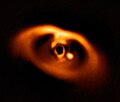 Illustration of the Kepler-90 system compared to the inner solar system. Kepler-90h is the outermost planet of the Kepler-90 system. | |
| Discovery | |
|---|---|
| Discovered by | Kepler spacecraft [1] |
| Discovery date | 2017 Shallue et al. [2] [1] |
| Transit [2] and deep learning, a class of machine learning algorithms. [1] | |
| Orbital characteristics | |
| 0.107+0.025 −0.040 [1] AU | |
| 14.44912±0.00020 [2] d | |
| Inclination | 89.20 +0.59 −1.30 [2] |
| Star | Kepler-90 |
| Physical characteristics | |
| 1.32±0.21 [2] R🜨 | |
| Temperature | 709 K (436 °C; 817 °F) [2] |
Kepler-90i (also known by its Kepler Object of Interest designation KOI-351.08) [2] is a super-Earth exoplanet with a radius 1.32 [2] times that of Earth, orbiting the early G-type main sequence star Kepler-90 every 14.45 days, discovered by NASA's Kepler spacecraft. [1] [3] It is located about 2,840 light-years (870 parsecs, or nearly 2.4078×1016 km) from Earth in the constellation Draco. The exoplanet is the eighth in the star's multiplanetary system. As of December 2017, Kepler-90 is the star hosting the most exoplanets found. Kepler-90i was found with the transit method, in which the dimming effect that a planet causes as it crosses in front of its star is measured, and by a newly utilized computer tool, deep learning, a class of machine learning algorithms. [1] [4] [5]





